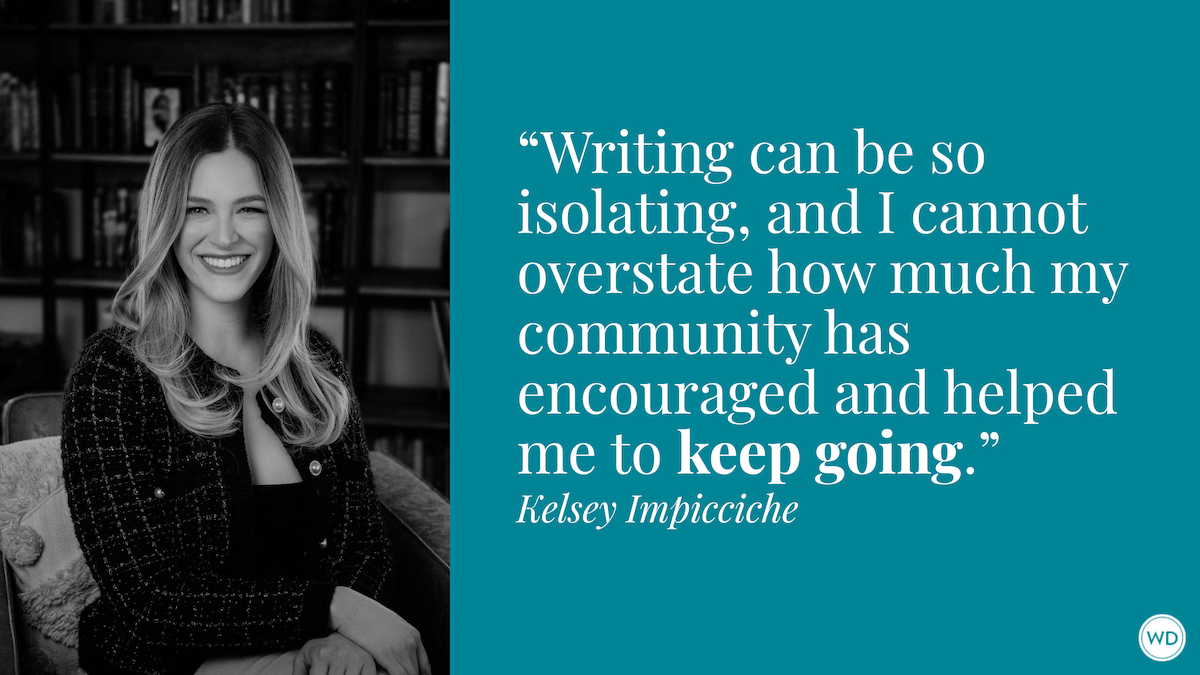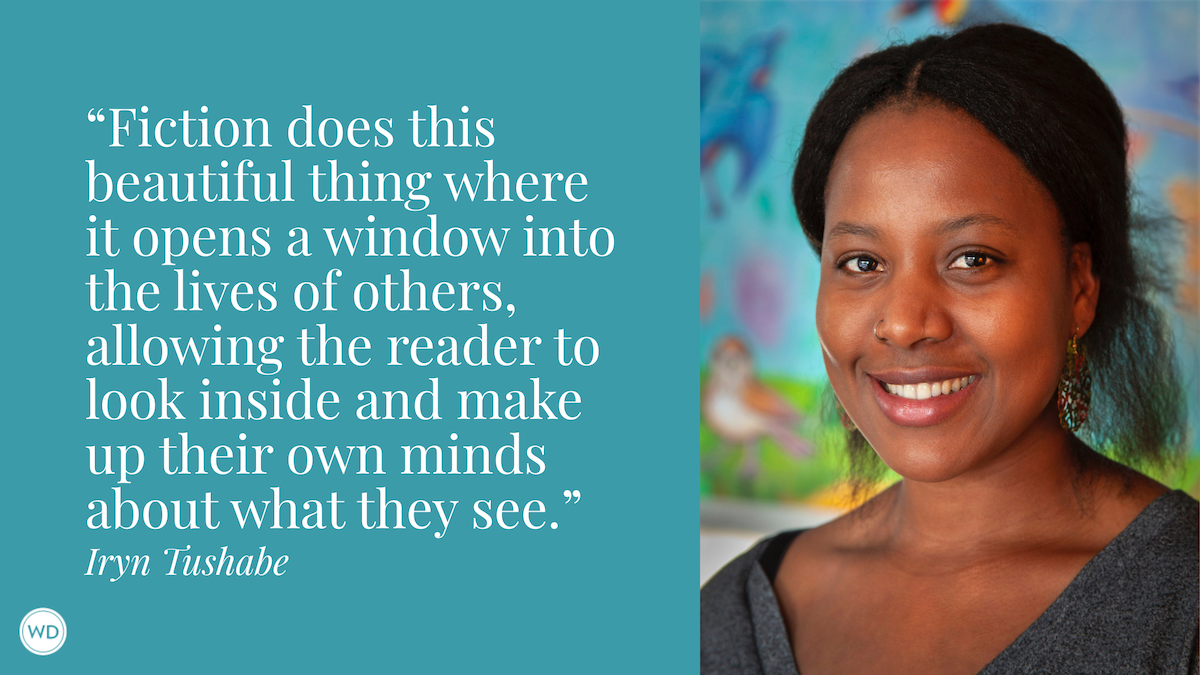Vintage WD: Just Say No
This August 1989 Writer’s Digest articles encourages writers to say no to their characters—in other words, create compelling conflicts in their stories.
by Gary Provost
Writer’s Digest, August 1989
Say no to your fiction characters—put obstacles in their paths—or else editors and readers alike will say no to your stories.
Hard-working Ted had a crush on Patty. One night at the Moose Lodge, Ted—though limping slightly from a hockey injury—asked Patter to dance and she said yes. Then he asked if she’d like to go candlepin bowling sometime and she said yes, that would be splendid. Ted got more and more infatuated with Patty, so he asked her to go steady and Patty said yes. Before long, Ted and Patty were in love. On a drizzly Tuesday afternoon at the coin laundry, Ted got down on his knees and asked Patty to marry him. Patty said yes. Ted said he wanted to live in Elgin, Illinois and he asked Patty if that would be OK with her. “Yes,” she said. “Yes, yes, Ted, I love you more than I love anything, including chocolate-covered cherries, and I want is to have three babies, OK?” Ted said, “Yes.” So, they moved to Elgin, where Ted applied for and got a job at the rope factory, and they had three healthy kids and lived happily ever after.
Pretty exciting stuff, huh?
Of course not. It’s dull. Ted has no opposition to his goals. He wants a dance and gets it. He wants a date and gets it. He wants a job in the rope factory and gets it. Watching Ted move through life is like watching a football team pass and run its way down the field with no opposition. Nobody tackles them. Nobody intercepts a pass. The outcome is never in doubt because nobody scores against them.
It’s great when things come easily in real life, but in fiction it’s a real snore.
The Ted-and-Patty story is dull because nobody ever says No. Without No, there isn’t any tension, any conflict, any excitement—and there isn’t any story, at least not a publishable one. For your fiction to work, continuous opposition must be trying to push back your character as he tries to push toward his goal. This resistance can be seen as a series of people, things and situations saying No to your character, or your character saying No to them.
Take a pencil and cross out any one of my yes’s in the Ted-and-Patty story. Replace it with a No, and watch what happens. Your interest level rises. You ask questions. How is Ted going to get Patty to change her mind and go out with him? What if Ted doesn’t want kids? Are Ted and Patty going to end up getting divorced over this Illinois thing?
Your fiction, whether short story or novel, shouldn’t be about a character getting everything served to him on a silver platter. It should be about a character who scraps and struggles and argues and overcomes, a character who damn near kills himself trying to beat down all the No’s between him and his goals. Every time he slays a few No’s, another battalion of them comes over the next hill. The sole reason for telling a story is that somebody or something said No. So, if things are going swell for your character, keep it to yourself. Nobody cares.
The compelling story is made up of one big No and many smaller no’s, most of which will melt into Yes’s along the way. Most new writers seem to understand the big No. It is the impending hurricane that says, “No, you can’t have a nice little town anymore.” It is the assassin who says, “No, the president can’t live past the 10 of August.” It is the prospect of divorce that says, “No. Sheila can’t have the happy marriage she always wanted.” Any of those can be the big No being shouted at your character all the way through the story, and we must wait until the end to see if our hero will tune it into a resounding YES.
But readers don’t turn pages to get to the end. They turn them to get to the next page. And so there must be dozens, even hundreds, of No’s along the way that create hurdles for your character to jump, problems for him to solve. Let’s take for example, Susan Isaac’s novel Compromising Positions. The novel could be about Judith, living a dull suburban life as a housewife. She hears about the murder of a local dentist and decides to investigate. She tells her husband this and he says, “Great, go ahead.” When the police find out she’s investigating, they say, “Keep up the good work, Judith.” When she becomes attracted to a policeman investigating the case, she tells herself, “Wonderful, I think I’ll jump into bed with him.”
Isaac’s novel could be like that, but it’s not. Isaac uses the essential No throughout. When Judith’s husband, Bob, finds out that she’s investigating the case, he says No. He doesn’t want her doing that, endangering their children, making a fool of herself. His opposition, his continual No, creates tension between husband and wife all through the story. By page 193, when somebody has warned Judith to keep out of the murder, Bob’s No has divided them.
“Would you like me to explain why I got involved in this case?” Business Week rose an inch as he took a deep breath. Otherwise he remained motionless, his gaze steady. Well? Shall I explain?”
“I really don’t care,” he said softly.
I squirmed a little. I swallowed. I ran my fingers over my eyebrows. “What do you mean, you don’t care?”
“I simply mean that if you are going to continue this insane quest of yours, if you are going to continue to subject the family to jeopardy, then I will simply do my best to protect my children and leave you to your own devices. You can do what you want.”
“Bob.” I walked to his side of the bed and touched his shoulder.
“Don’t touch me Judith. Don’t touch me again until you get your head screwed on straight again. Do I make myself understood?”
He turned over and reached for the light. I undressed in the dark and climbed under the cold cover to lie on even colder sheets. “Bob.” I whispered, easing over to his side of the bed. “Bob.” He shook his body as though ridding himself of a pesty mosquito. I inched away, fluffed my pillow into a high, soft mound, pulled the quilt over my ears and, eventually, fell asleep.
When the police find out that Judith is investigating, they say No. You’re an amateur, they tell her: you’re putting yourself in danger, impeding the investigation.
And when Judith and detective Nelson Sharpe start making bedroom eyes at each other in her kitchen, she tells him No.
“And you’re goddamn insensitive,” I replied harshly, trying not to cry and feeling my throat tighten with the effort. “Can’t you understand that when I say no I mean no? I’m not being coy with you. If and when I decide I want to sleep with you, I’ll drop you a line. Okay? If you’re still interested, fine. If you’re not, you’re under no obligation. But right now I can’t get involved.”
All of these No’s melted into Yes’s as the story went along. Judith’s husband grudgingly accepted that she needed some excitement and could continue to investigate the murder. The police eventually welcomed Judith into the investigation, even asked her to help. And both Judith and Nelson Sharpe finally said Yes to lust, and ended up in a motel together.
This principle works at every level of the story. In your story, Joel has a big goal, such as stopping a computer virus from reaching a computer that controls nuclear missiles. Joel also has many important intermediate goals, such as convincing the President that his plan to kill the virus will working. And he has more even-smaller goals, such as getting in to see the President, or even finding a cab so that he can get to the White House on time. Just as there are goals at every level, there is opposition at every level. Make it difficult for Joel to get in to see the President. When he finally gets in, make it more difficult for him to convince the President. When he finally convinces the President, make it almost impossible for Joel to kill the virus. Etc. Never let things go smoothly for long.
You can’t have major goals and major No’s on every page, so the little no’s along the way will keep the reader on edge. For example, in a Compromising Positions scene, a detective hands Judith an envelope full of pornographic pictures of women, taken by the murder victim. If Judith can recognize some of the women, they might have clues to the murderer’s identity. Judith opens the envelope, finds the pictures disgusting and says, No.
These are women who might be my friends—even me. They have kids, the squeeze cantaloupes in the supermarket. And suddenly, I’m looking in on their inner life, which they never thought would go public.
She hands the photos back.
Later, she does look at the photos, identifies one woman, and the story moves forward. This is just a little no, and Judith looking at the photos in the first place would not have sabotaged the story. But these little no’s along the way create reader commitment by putting the big goal and thew intermediate goals in jeopardy. Little no’s are the immediate concern of the readers. Little no’s make readers worry, and turn pages.
REVERSALS
The trick is getting from No to Yes in a believable way. If a character says No, No, No, then changes his minds for no apparent reason, the reader will feel cheated and the story will wilt. One major way to get a character from No to Yes in a way readers will accept is to raise the stakes.
No’s create tension because something is a stake. If the character can’t turn the No into a Yes, the company will be destroyed, the bunnies will lose their home, or the perfect husband will end up in the arms of another woman. So one common way of making a believable transition from No to Yes is to raise the stakes. A person who says no for a dime might say yes for a dollar. To raise the stakes:
- Increase the potential gain for saying Yes. For example, a beautiful woman walks into a private detective’s office and asks him to take on a case that requires him to go to Cleveland for two weeks. He says no. By the end of the scene she has made it clear that she will go with him, and makes herself romantically available. He changes his mind.
Increase the potential harm from saying No. In Tootsie, for example, Michael Dorsey (Dustin Hoffman) pretends to be an actress so he can earn $9,000 to produce his roommate’s play. By the time the film is half over, Michael has certainly earned that much from starring in a soap opera, so now he’s ready to say No to the female impersonation. How do the writers raise the stakes to make him say Yes? Michael, as Dorothy, falls in love with Julie (Jessica Lange), who keeps talking about how much she admires Dorothy for her honesty. Now if Michael says No to the impersonation, the consequences are greater: he will lose Julie’s respect.
Blackmail is a device for increasing the harm from saying No. If your character says No and then learns that something terrible will happen to him if he doesn’t change his mind, he might change his mind. A typical example: Willy the Weasel says he won’t testify against the mobster. Then he learns that the DA has evidence that Willy robbed s liquor store last year and will prosecute unless Willy testifies. Willy says Yes.
- Increase urgency. Make the character more aware of or more concerned with the stakes you’ve already established. For example, you might start a clock ticking: An unexpected deadline can often persuade a character to go from No to Yes. For example, a young diabetic has been kidnapped, and your policewoman character says No to an illegal search of a suspect’s house. She wants to wait for a warrant. But then she finds out that the victim has enough insulin for only three days. Now the clock is ticking. She says Yes to the illegal search.
- Reduce the potential harm or risk from saying Yes. Sometimes a character will go from No to Yes if you make the Yes a little easier. Maybe your ex-sheriff, Marvin, has said No to hunting down the bank robbers because there are too many of them for one man to handle. Then he turns to his old pal Trigger Maddox, who is looking for a little excitement and offers to go along with Marvin. Marvin has help now, so he says Yes.
Raising stakes is effective, but the best and most subtle way to get your character from No to Yes is to exploit personality. Before the character ever says No, reveal, through story events, some aspect of his nature. Something in his past prompts the character to a new understanding, provides a new insight or presents a new challenge that makes him say Yes.
Perhaps he was a coward years ago and vowed he would never be one again. Somehow he is shown that his No was cowardly, so he changes it to Yes. Maybe your successful business-woman has said No to running an important charity because it would mean a cut in pay. Then she realizes that she has sold out her principles for money, something she swore she would never do. She says Yes.
In my short story “Big Brother,” Scotty—a lonely middle-aged man abandoned by his wife—decides to become a Big Brother. Here he talks to Neil Feirstein, a counselor trying to find the right kid for Scotty.
Now another week had passed and here I was sitting across from Neil Feirstein, wondering: if I had a son, would I want him being influenced by a man like me?
Here is Scotty saying No to the whole idea. Even though he’s applied for Big Brother, he is still resisting. They talk for a while about what kind of kid would be best for Scotty.
Feirstein looks at me for a long time and then he said, “Cub.”
“Cub?”
“His real name if Charles. Charles Banks. Everybody calls him Cub. Eleven years old.
Without looking at the names, Feirstein reached into his stack and pulled out the third manila folder. I suspected that he had been planning to foist this one off on me even before I came through the door
Scotty is still saying No, he’s still resisting by getting into a negative frame of mind about this kid.
“Cub’s a funny kid.” He said. “He comes to all the events even though he doesn’t have a Big Brother yet. He keeps asking me, ‘Have you got someone yet, huh, have you got someone?’ He can be a pain in the ass sometimes, they all can. But he’s OK. He’s got some rascal in him, but he’s likable.
“What kind of rascal?”
Dodging or procrastinating is another way of saying No—in this case, asking questions instead of agreeing is procrastinating.
“Oh, I don’t mean he’s lifting Pontiacs or anything. But. Well, let me put it this way, if you leave your lucky rabbit’s foot and your wallet out on the table when Cub’s there and you go out of the room, don’t look for your rabbit’s foot when you get back. Cub will pocket it. But he won’t touch your cash.”
“A kleptomaniac?” I said. “You want to match me with a klepto?”
“These kids are not perfect,” Feirstein said. “A lot of them have been abandoned by fathers and them again by step-fathers or maybe some boyfriend of the mother that the kid got attached to.”
They go on for a while, with Scotty asking questions about Cub’s interests. Scotty is getting closer and closer to Yes, but he is still resisting.
I was having a hard time just saying “yes, Cub will do fine.” This was important. Would I hit it off with this kid? Would we have fun together or would he be obnoxious? Would he like me?
“Was Cub abandoned?” I asked.
Feirstein glanced at the folder. "Father took off when Cub was six.”
“I’ll take him,” I said.
Scotty’s No has melted into when he realizes that Cub was abandoned, just as Scotty was abandoned by his wife. He identifies with the boy. He cares about him. In the scene, Scotty has grown to the point where he can believably give up his No’s and turn to Yes.
While I have emphasized the No’s coming from characters, keep in mind the other kinds of No’s—those from situations. A locked door means No to the man who wants to get in. An alcoholic past says No to the woman who wants to run for Congress. Terminal cancer says No to the priest who wants to live long enough to find his brother. Situations, generally, shouldn’t change character’s minds; characters should change situations. For example, if the situation is a hot, dry and hostile desert saying to your character, “No, you can’t survive, you can’t have water,” and then an oasis suddenly appears, there is little reader satisfaction. On the other hand, if the character changes the No to a Yes, by finding an oasis through his own cleverness, instincts, courage or whatever, readers are satisfied.
Also, keep in mind what I said about revealing the needed character information before the No. Don’t get your character into a locked closet and then, in effect, write, “By the way, Joe is an expert on locks.” Decide what tools, qualities or history the character requires for his Yes and give them to him before he says No (the private detective had an eye for the ladies before he said no, the police-woman had compassion before she said no, and Willy was a weasel before he said no).
Keep those waves of opposition coming all through your story and you’ll find that a lot of editors who have been saying no to you will now say yes.
___________________________________
Gary Provost, was a WD Correspondent, is the author of Beyond Style: Mastering the Finer Points of Writing, Make Every Word Count and The Freelance Writer’s Handbook.








